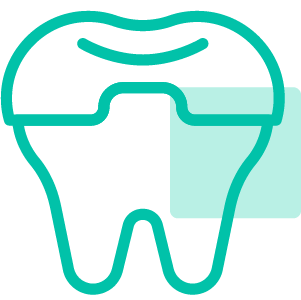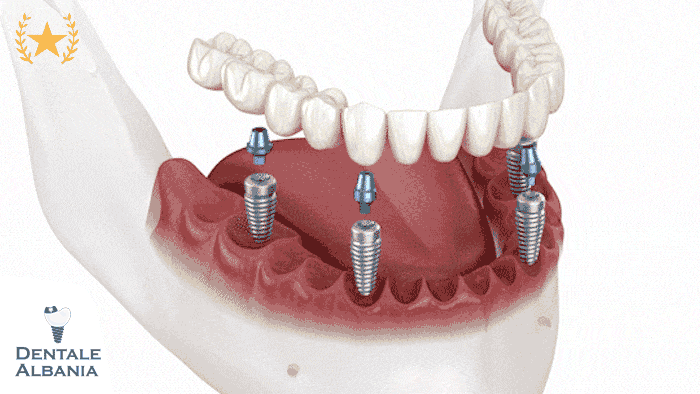Table of Contents
ToggleWhat Are Dental inlays and onlays?

Inlays and onlays are specialized dental restorations used to restore teeth that have sustained damage or decay. Unlike regular fillings, which are placed directly into a cavity, inlays and onlays are custom-made restorations crafted in a dental lab before being placed into the tooth. They are used when the tooth has experienced more significant damage than a regular filling can handle but does not require a full crown.
What is an Inlay?
An inlay is a restoration that fits inside the cavity of the tooth. It is typically used for teeth that have a decayed or damaged area inside the cusps (the raised, pointed parts of the tooth). Inlays are typically made from materials such as porcelain, composite resin, or gold, and they are designed to match the natural shape and color of the tooth.
- Material choices: Porcelain inlays blend seamlessly with the natural tooth color and are commonly used for their aesthetic appeal. Gold inlays are known for their strength and durability, though they are less commonly used for front teeth due to their color.
- Procedure: The process for getting an inlay involves removing the decayed area of the tooth, taking an impression of the tooth, and sending it to a lab for fabrication. A temporary filling is placed while waiting for the custom-made inlay.
What is an Onlay?
An onlay is similar to an inlay, but it extends over the cusps of the tooth. Onlays are used when a more extensive part of the tooth is damaged, and they can cover one or more of the cusps. Onlays are ideal for teeth that need extra support and for situations where a crown would be too invasive.
- Material choices: Like inlays, onlays are typically made from porcelain, composite resin, or gold. Porcelain onlays offer a natural-looking restoration, while gold onlays are durable and long-lasting.
- Procedure: The procedure for an onlay is similar to that for an inlay, with the key difference being that more of the tooth surface is covered. The process involves preparing the tooth, taking an impression, and sending it to the lab for fabrication.
What Materials Are Used for Inlays and Onlays?
The materials chosen for inlays and onlays depend on the patient’s needs and preferences. The most common materials are porcelain, composite resin, and gold.
- Porcelain: Offers an aesthetic solution that closely matches the color of natural teeth, making it ideal for visible teeth. It is durable and resistant to staining.
- Composite Resin: A tooth-colored material that is often used for inlays and onlays in cases where aesthetics are important, though it is less durable than porcelain or gold.
- Gold: Known for its strength and longevity, gold is often used in back teeth restorations where strength is more important than aesthetics.
Inlays and onlays are designed to restore the tooth to its natural function and appearance. They are a great alternative to traditional fillings and crowns and offer long-term benefits in terms of both strength and aesthetics.
How Do dental inlays and onlays Differ from Fillings and Crowns?
Dental inlays, onlays, fillings, and crowns are all restorative dental treatments used to repair damaged or decayed teeth, but they each serve different purposes and require different procedures. Understanding the key differences between these treatments can help you choose the best option for your specific dental needs.
Inlays vs. Fillings
While both inlays and fillings are used to restore damaged teeth, they differ significantly in their size, material, and method of placement.
- Fillings: Fillings are typically used for smaller cavities and are applied directly into the cavity once the decay is removed. They are a quick, cost-effective solution that can be made from materials such as amalgam (metal), composite resin, or porcelain. Fillings are placed in a single visit, and they are ideal for minor decay or damage.
- Inlays: Inlays, on the other hand, are used when the damage to the tooth is more extensive but not enough to require a crown. Unlike fillings, inlays are custom-made in a dental lab to precisely fit into the cavity. They are typically made from porcelain, composite resin, or gold and offer a more durable and aesthetically pleasing solution. Inlays are bonded into place with a cement adhesive.
Onlays vs. Crowns
Onlays and crowns are both used to restore more heavily damaged teeth, but they differ in terms of coverage and the amount of tooth structure that needs to be removed.
- Crowns: A crown, also known as a cap, completely covers the visible portion of a tooth, offering full restoration when the tooth is severely damaged or weakened. Crowns require the removal of a significant portion of the natural tooth structure to ensure the crown fits securely. They can be made from various materials, including porcelain, ceramic, metal, or a combination of these. Crowns are often used when a tooth is too damaged for a filling or an inlay but does not require extraction.
- Onlays: Onlays, while similar to crowns, are less invasive. They cover only the outer surfaces of the tooth, including one or more cusps. Unlike crowns, onlays preserve more of the natural tooth structure, making them a less destructive option for teeth that have not suffered complete destruction. Onlays are custom-made in a lab, like inlays, and they can be made from porcelain, composite resin, or gold.
Both inlays and onlays provide an excellent balance of durability and aesthetics, offering a more conservative option compared to crowns, which require extensive reshaping of the tooth.
Why Would a Dentist Recommend Inlays or Onlays?
Dentists often recommend inlays or onlays when a tooth is too damaged to support a standard filling, but not severely damaged enough to require a crown. These treatments are favored for their ability to restore a tooth’s functionality while preserving as much of the natural tooth structure as possible.
For Larger Cavities
When a cavity is too large for a regular filling, inlays and onlays provide a more effective and durable solution. While fillings are great for minor decay, they do not offer the same strength and longevity as inlays and onlays. Inlays are typically used to fill cavities that are located between the cusps (the raised points) of the tooth. Onlays are used when the damage extends to one or more cusps or the chewing surface of the tooth. By custom-making these restorations to fit precisely into the cavity, inlays and onlays restore the natural function of the tooth while ensuring a more robust solution than a simple filling.
To Preserve Tooth Structure
One of the primary advantages of inlays and onlays over crowns is that they require less removal of the natural tooth structure. While crowns cover the entire tooth and necessitate the removal of a significant portion of the tooth, inlays and onlays only require removal of the decayed or damaged part. This preservation of natural tooth structure helps maintain the tooth’s strength and integrity, ensuring it can continue to function properly. Additionally, less tooth structure removal leads to better long-term outcomes for the tooth, as it minimizes the chances of future complications like tooth sensitivity or damage.
What Are the Benefits of Dental Inlays and Onlays?
Inlays and onlays offer a variety of benefits that make them a popular choice for restoring damaged teeth. These benefits include their durability, aesthetic appeal, and ability to improve tooth strength. By providing a solution that blends seamlessly with natural teeth, inlays and onlays are an excellent choice for those seeking both functionality and aesthetics.
Durability and Longevity
Inlays and onlays are known for their exceptional durability, especially when compared to traditional fillings. Made from strong materials such as porcelain, composite resin, or gold, these restorations can last anywhere from 10 to 30 years with proper care. Unlike fillings, which may degrade over time due to wear and tear, inlays and onlays are designed to withstand the pressures of chewing and grinding, making them an excellent long-term solution for tooth restoration.
Their longevity is partly due to their custom fabrication process. Since they are created in a dental laboratory to precisely match the size and shape of the cavity, inlays and onlays provide a tight fit that reduces the risk of decay forming around the edges. As a result, they often last much longer than fillings, requiring fewer replacements or touch-ups.
Aesthetic Appearance
One of the primary reasons patients opt for inlays and onlays is their natural, aesthetic appearance. Porcelain and composite resin inlays and onlays can be custom-matched to the color of the patient’s teeth, ensuring that the restoration blends seamlessly with the surrounding dental structure. This makes them particularly popular for restorations in the visible areas of the mouth, where cosmetic appearance is important.
Gold, while durable, is less commonly used for aesthetic purposes, as its color stands out against natural teeth. However, for those who prioritize strength over appearance, gold inlays and onlays can still provide excellent durability. For most patients, though, porcelain and composite options are the preferred choices for their natural look and ability to mimic the appearance of real tooth enamel.
Improved Strength
Inlays and onlays not only restore the damaged area of the tooth but also improve the overall strength of the tooth. These restorations can increase a tooth’s strength by 50-75%, which helps prevent further damage or fractures. Since inlays and onlays are custom-made to fit the tooth precisely, they provide more structural support than fillings, which may weaken over time.
Additionally, the materials used in inlays and onlays, particularly porcelain and composite resins, are highly resistant to wear and stress. This makes them an ideal choice for restoring teeth that undergo significant pressure from biting and chewing. By restoring the tooth’s function and protecting it from further damage, inlays and onlays ensure the tooth can continue to serve its purpose effectively.
How Long Do Dental Inlays and Onlays Last?
Dental inlays and onlays are known for their long-lasting durability. The lifespan of these restorations can vary depending on the material used, the care they receive, and the patient’s oral hygiene habits. However, with proper maintenance, both inlays and onlays can last significantly longer than traditional fillings, making them a worthwhile investment for those needing tooth restoration.
Durability of Porcelain Inlays and Onlays
Porcelain inlays and onlays are some of the most durable options available for tooth restoration. On average, these restorations can last between 10 to 30 years. The longevity of porcelain inlays and onlays is influenced by factors such as how well the patient cares for their teeth and how much pressure the restoration is subjected to (e.g., chewing hard foods or grinding teeth). Porcelain is particularly strong and resistant to staining, which means it maintains its aesthetic appearance throughout its lifespan.
To extend the lifespan of porcelain restorations, regular dental check-ups are essential. These visits help monitor the condition of the restoration and catch any potential issues before they become significant problems.
Gold vs. Porcelain
When it comes to durability, gold inlays and onlays are often considered the gold standard. They are incredibly strong and can last for decades—often outlasting porcelain restorations. Gold restorations are particularly effective for back teeth that endure heavy chewing forces. However, gold is not as aesthetic as porcelain, which is why it is less commonly used for front teeth restorations.
The choice between gold and porcelain comes down to the specific needs of the patient. For those prioritizing strength, especially for back teeth, gold may be the best option. For patients seeking a more natural look, porcelain is the preferred choice. While gold inlays and onlays may last longer, porcelain provides an excellent balance of durability and aesthetics, making it a popular choice for most patients.
What Does the Procedure for Inlays and Onlays Involve?

The process of getting dental inlays and onlays is relatively straightforward but requires at least two visits to the dentist. Unlike regular fillings, which can be applied directly into a cavity, inlays and onlays are custom-made restorations that are created in a dental laboratory. Here’s what to expect when you undergo this procedure.
Step 1: Preparation
The first step in getting an inlay or onlay involves preparing the tooth. The dentist will remove any decay or old fillings and clean the affected area. Once the tooth is cleaned, the dentist will shape the cavity to ensure that the inlay or onlay fits perfectly. The goal is to remove as little healthy tooth structure as possible while ensuring the restoration fits securely.
In some cases, if the cavity is too deep, the dentist may need to build up the tooth structure to provide better support for the inlay or onlay. After the preparation is completed, the dentist will take an impression of the tooth. This impression will be sent to a dental lab, where the custom restoration is made. To protect the tooth while waiting for the permanent restoration, the dentist may place a temporary filling.
Step 2: Impression
After the tooth is prepared, your dentist will take an impression of the cavity using a special dental material. This impression is used to create a custom-fitted inlay or onlay that precisely matches the shape of your tooth. In most cases, the impression is sent to a dental lab, where skilled technicians fabricate the restoration using materials like porcelain, composite resin, or gold.
In some advanced dental practices, the impression and fabrication process can be done digitally using CAD/CAM technology, allowing for a quicker turnaround and reducing the need for multiple visits. However, most traditional methods require sending the impression to the lab, which can take one to two weeks to return with the final restoration.
Step 3: Fitting the Restoration
Once the custom-made inlay or onlay is ready, you’ll return to your dentist for the final fitting. The dentist will remove the temporary filling and check the fit of the new restoration. The inlay or onlay is then cemented into place with a special dental adhesive. After the restoration is securely bonded to the tooth, the dentist will ensure that the bite aligns properly and make any adjustments needed for comfort.
The dentist will also check for any rough edges or excess cement and smooth everything down to ensure the restoration feels comfortable and functions naturally with the surrounding teeth. Once satisfied with the fit, the procedure is complete, and you can resume your normal activities, although you may need to avoid certain foods temporarily while your new restoration settles.
How Much Do Inlays and Onlays Cost?
The cost of dental inlays and onlays can vary based on several factors, including the material used, the complexity of the procedure, and your geographic location. While these restorations tend to be more expensive than regular fillings, they offer greater durability, aesthetic appeal, and functionality, making them a worthwhile investment for many patients. Here’s a breakdown of the cost factors you should consider when opting for inlays and onlays.
Cost of Inlays vs. Fillings
Inlays tend to be more expensive than traditional fillings. Fillings, especially those made from amalgam or composite resin, are the most affordable dental restoration option. However, they may not last as long or provide the same aesthetic appeal as inlays. The average cost of a dental filling can range from $100 to $500, depending on the material used and the size of the cavity.
In contrast, inlays require more time and expertise to create, as they are custom-made in a dental lab. This additional step in the process, along with the materials used, raises the cost of inlays. The average cost of a dental inlay ranges from $600 to $1,500 per tooth, with porcelain inlays typically being on the higher end of the price spectrum due to their aesthetic qualities and strength.
Cost of Onlays
Onlays are generally more expensive than inlays because they cover a larger portion of the tooth, including one or more cusps. The cost of a dental onlay can range from $700 to $2,000 per tooth, depending on the material used and the complexity of the procedure. Gold onlays, while highly durable, tend to be on the higher end of the cost scale. Porcelain onlays are also commonly used for their natural appearance and durability, though they can be slightly less expensive than gold options.
Like inlays, onlays require custom fabrication in a dental lab, and the process involves multiple visits to the dentist. This means that the cost includes both the lab fees and the time spent on the procedure, which contributes to the overall expense.
Factors Affecting the Cost of Inlays and Onlays
Several factors can influence the cost of inlays and onlays:
- Material Choice: Porcelain and composite resin materials tend to be less expensive than gold or zirconia options. Porcelain is popular for its natural appearance, while gold is chosen for its strength and longevity.
- Geographic Location: Dental prices can vary significantly based on where you live. Areas with a higher cost of living may have higher dental fees.
- Dentist Expertise: Highly experienced dentists or specialists, such as prosthodontists, may charge more for their services due to their advanced skills and knowledge in performing these procedures.
- Insurance Coverage: Depending on your dental insurance plan, some or all of the cost of inlays and onlays may be covered. It’s important to check with your insurance provider to see what is covered under your plan.
While inlays and onlays are a significant investment compared to regular fillings, their durability, functionality, and aesthetic benefits often make them worth the cost in the long run.
Are Dental Inlays and Onlays Covered by Insurance?
One of the common questions patients ask when considering inlays and onlays is whether their dental insurance will cover the costs. Since inlays and onlays are more expensive than regular fillings, understanding your insurance coverage is crucial. The extent of the coverage will vary depending on your insurance plan, whether it’s a private plan or public coverage like the NHS in the UK.
Private vs NHS Coverage
In some cases, NHS coverage for dental inlays and onlays is available, but it is generally limited to specific conditions and treatments. The NHS often provides coverage for essential dental procedures, including fillings, crowns, and sometimes inlays or onlays when necessary for health reasons. However, there are restrictions on the materials used and the types of restorations covered. For example, the NHS may only cover basic amalgam inlays or onlays, while porcelain or composite options may not be covered.
If you are seeking higher-quality materials, such as porcelain or gold inlays and onlays, you may need to opt for private dental care. While the NHS can be a more affordable option, private insurance or paying out-of-pocket will provide you with a broader selection of materials and restoration choices.
Private Insurance
With private dental insurance, you are more likely to have better coverage for inlays and onlays, but the specifics will depend on the plan. Some dental insurance policies fully or partially cover the costs of inlays and onlays, particularly when they are deemed medically necessary due to tooth decay or damage. However, it’s important to understand that dental plans may not fully cover cosmetic procedures or restorations that are primarily used for aesthetic purposes.
It is essential to check your dental insurance policy for the specific terms and conditions related to coverage for inlays and onlays. Some insurance providers may cover a portion of the treatment costs, while others may have higher out-of-pocket expenses. Additionally, many insurance plans have an annual maximum payout, so it’s essential to understand the limits of your plan.
Understanding Your Coverage Options
To ensure you’re making the most of your dental insurance benefits, it’s helpful to:
- Verify Coverage Details: Contact your insurance provider or dentist to discuss the specifics of what is covered under your plan. Ask about any exclusions or limitations on restorative dental work.
- Consider a Dental Discount Plan: If you don’t have dental insurance, you may want to explore dental discount plans. These plans can help lower the cost of procedures, including inlays and onlays, by providing discounted rates from participating dentists.
- Talk to Your Dentist: Your dentist’s office staff can help you understand the insurance process and may even assist in submitting claims or verifying your coverage.
While dental inlays and onlays can be a significant investment, understanding your insurance coverage can help reduce the financial burden. Always ensure that you review your options and know what your plan covers before starting treatment.
Do Inlays or Onlays Require Special Aftercare?
Once your inlays or onlays are placed, proper aftercare is crucial to ensure the longevity of your restoration and the health of your tooth. While inlays and onlays are durable and can last many years, following the right care guidelines is essential for maintaining their function and appearance.
Regular Brushing and Flossing
One of the most important aspects of aftercare for inlays and onlays is maintaining a good oral hygiene routine. This includes brushing your teeth at least twice a day with fluoride toothpaste and flossing once daily. Regular brushing helps prevent plaque buildup, which can lead to decay or gum disease around the edges of the restoration.
- Brush Gently: Use a soft-bristled toothbrush to avoid putting too much pressure on the restoration and surrounding teeth.
- Floss Carefully: Be gentle when flossing to avoid damaging the restoration. Flossing helps remove food particles and plaque from between your teeth, ensuring that the inlay or onlay stays clean and in good condition.
- Use Non-Abrasive Toothpaste: To avoid damaging the surface of your inlays or onlays, choose toothpaste that is non-abrasive and safe for dental restorations.
Avoiding Certain Foods
While inlays and onlays are strong and durable, it’s essential to avoid certain foods that could potentially damage them or your natural teeth. Hard and sticky foods, for example, can put excessive pressure on your restoration, leading to cracks or dislodging the material.
- Hard Foods: Avoid biting directly into hard foods like ice, hard candy, and nuts. These can cause chips or fractures in your restoration.
- Sticky Foods: Foods like caramel, chewing gum, and taffy can stick to your restorations and may pull on them, causing them to become loose.
- Acidic Foods and Drinks: While inlays and onlays are resistant to stains, acidic foods and drinks like citrus fruits, soda, and vinegar can still affect the surrounding enamel. It’s best to consume these in moderation and rinse your mouth with water afterward.
Regular Check-ups
Regular dental check-ups are essential to monitor the condition of your inlays or onlays. During your routine visits, your dentist will check for any signs of wear or damage and ensure the restorations are still functioning properly. If there are any issues, they can address them promptly before they become more significant problems.
- Annual Check-ups: Even if you’re not experiencing any pain or discomfort, it’s important to visit your dentist regularly for exams and professional cleanings.
- X-rays: Your dentist may also take X-rays to check for any issues beneath the surface, such as tooth decay that could be affecting the restoration.
By following proper aftercare and visiting your dentist for regular check-ups, your inlays and onlays can provide you with long-lasting, natural-looking restorations that will continue to support the function and health of your teeth.
Frequently Asked Questions About Inlays and Onlays

As with any dental procedure, patients often have many questions regarding inlays and onlays. Here, we’ll answer some of the most common inquiries about these restorations, from their differences to their care.
What is the Difference Between an Inlay and an Onlay?
- Inlays are restorations that fit inside the tooth, covering only the surface between the cusps (the raised points on a tooth). They are typically used for smaller cavities that don’t affect the chewing surface.
- Onlays, on the other hand, are larger restorations that cover one or more of the cusps of the tooth and are used when more substantial damage or decay has occurred. Onlays can sometimes be referred to as partial crowns because they cover a more significant portion of the tooth than inlays, without needing to remove as much of the tooth structure as a crown would.
The choice between an inlay or onlay depends on the extent of the tooth’s damage and how much tooth structure remains. Your dentist will help determine the best option based on these factors.
Are Inlays Better Than Fillings?
Inlays offer several advantages over traditional fillings, making them a better choice for certain situations. Here’s why:
- Durability: Inlays are made from stronger materials like porcelain, composite resin, or gold, which last longer than standard fillings. They can endure the pressure of chewing more effectively and are more resistant to wear and tear.
- Aesthetics: Inlays, especially those made of porcelain, are much more natural-looking than metal fillings, blending seamlessly with your natural teeth.
- Better Fit: Inlays are custom-made in a lab and fit more precisely in your tooth, reducing the risk of decay at the margins, which can be a problem with fillings that shrink or wear down over time.
While fillings are still an excellent option for smaller cavities, inlays are often the better choice for larger or more extensive damage, providing both strength and a more aesthetically pleasing result.









